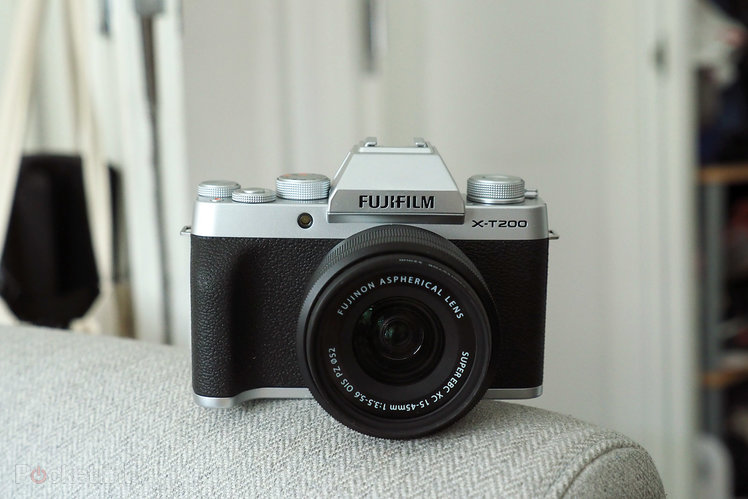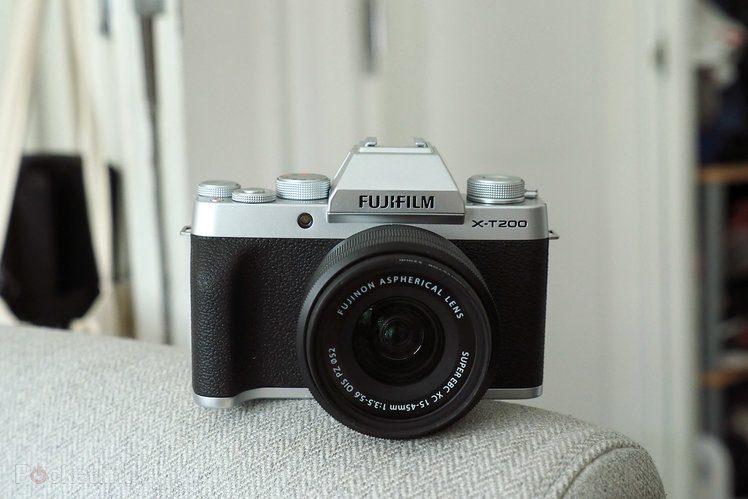
When we reviewed the Fujifilm X-T100 back in 2018 we were a bit flummoxed about how it was supposed to sit within this high-end camera series. Two years on and its follow-up, the X-T200, has arrived. Featuring an updated design and new feature set, can it convince us where its predecessor could not?
We’ve long been fans of Fujifilm’s mirrorless cameras, because the X series is all about doing things differently. Whether that’s the unique viewfinder of the X100V, or the impressive sensor technology in the X-T4. Except the X-T200 doesn’t leverage any of that, largely because it doesn’t use the X-Trans CMOS sensor design of the rest of the X-T mirrorless range.
The Fujifilm X-T200 is therefore the company’s unabashed entry-level push in the interchangeable lens market. It’s the camera that wants you to ditch your smartphone. But does it all add up?
Design & Lens Mount
- Fujifilm X mount (for XF lenses)
- Built-in electronic viewfinder (0.39in, 2,360k-dot OLED)
- Vari-angle mounted screen, with touch controls (3.5in, 2,760k-dot LCD)
While many camera makers release incremental updates of a series, Fujifilm has re-thought things a little more for the X-T200. It’s redesigned, thus about 80g lighter than its predecessor (just 370g for the body), the intent being to appeal to those who baulk at the idea of carrying a big and heavy camera around.
That’s why it comes equipped with a retracting power-zoom lens, too, rather than depending on the pricier and more advanced lens options in the range. These XF lenses do still fit the camera, of course, if you wish to buy any for your collection – that’s always part of the appeal and point of an interchangeable camera.
The retro looks are appealing, but the X-T200 avoids the mass of labelled dials that the more traditional models in the series feature. Instead there’s a mode dial with manual controls, plus a bunch of scene modes. It makes sense, in that we get it, but it doesn’t make sense, in that it feels like the outlier in the X-T series.
Elsewhere the X-T200 comes fully featured on the screen and viewfinder front. The fact is has the latter built-in will be as much an appealing element as it may be a deterrent for some others; it’s a good finder, though, with ample resolution and helpful for when sunlight is too bright.
The 3.5-inch rear touchscreen is now bracket mounted, so it can open through 180-degrees or rotated between 90-to-180-degrees. That’s useful for overhead shooting, waist-level work, or rotating the camera between portrait and landscape when in such scenarios.
Performance
- Autofocus with 117 selectable areas
- Face Detection & Eye Detection AF
- Adjustable AF point size
- Up to 8fps burst
Let’s explain the X-T100’s smattering of dials: there’s a Film Simulator to one side; a mode dial, and twin top dials (this pair change their function depending on selected mode) to the other side.
When clicking between Film types using the top dial, there’s a neat effect where the camera shows you the live image, a line drawn down the middle, to compare current selection (Provia) and whatever else you’re looking to use (Velvia – vivid, Astia – soft, Classic Chrome, Pro Neg – Hi/Std, Monochrome (with Yellow/Red/Green filter options), and Sepia. It’s a nice touch – even if the frame-rate slows somewhat due to the processing asks.
The pre-set scene modes on the main mode dial seem like a compact camera feature that’s trying to creep into a more serious camera, but the inclusion of Night (for completeness: there’s also Sport, Landscape, Portrait) shows the camera is able to push settings beyond their normal restrictions, which can be really handy.
That’s one of the things about the X-T200: the included power-zoom lens has its limitations given its limited maximum aperture. By default you might find it will mean a very limited shutter speed is selected, which may not be appropriate for the scene. That said, the optical stabilisation (OIS) system is rather impressive: we’ve been able to shoot at 1/15th second without much bother, which is something you won’t get away with on your phone.
Elsewhere the X-T200 improves upon the autofocus system of its predecessor. With a total of 117 areas to select from, incuding area size adjustment, it’s possible to select one, an area/group, and move the focus area around using the touchscreen or rear lever (a physical control that lacked on its predecessor).
The autofocus system is adept, as it’s utilising an improved on-sensor system, but some of the implementation isn’t perfect. For example: when the cameras sometimes throws back “AF!” in a red box when it’s unable to focus, it isn’t over-ridden with a half press of the shutter button, as you would expect. Which isn’t intuitive for a camera of this type.
However, the inclusion of Face/Eye detection (including left/right eye priority) is really useful for portraits and group scenes. This used to be the reserve of higher-end cameras only.
Image Quality
- ‘New’ 24.2 million pixel sensor, APS-C size
- Standard primary colour filter (not X-Trans CMOS)
- Video capture: 4K at 30fps, Full HD (1080p) at 60fps
The X-T200 also includes a brand new sensor. Yes, it’s the same 24.2-megapixels of resolution as the outgoing X-T100’s, but it’s been engineered differently, has phase-detection autofocus points on the sensor itself – hence that improved focus ability compared to the last model – and a processor that’s three-and-a-half times quicker than its predecessor too.
That additional speed means burst shooting to eight frames per second (8fps) at full resolution, while 4K video is also possible to 30fps. That’s knocking on the door of much more expensive cameras in both departments.
What you really want to know about is what the pictures are like. As the X-T200 does things differently to its X-series family – there’s no X-Trans CMOS sensor, it’s a ‘normal’ sensor and colour array here – it’s something of a departure in process.
But that doesn’t mean the pictures are poor. Indeed, it’s quite the opposite. Which is a major reason to consider buying the X-T200 in the first place.
The thing that really stands-out from a camera with a large sensor such as this is two fold: one, how good image quality can be in low-light conditions; two, how standout the blurred background effect is, giving much more pro-looking results.
Despite the power zoom lens’ limited aperture, we’ve been shooting indoors and the camera has handled limited light really well by pushing the ISO sensitivity up. Even at ISO 3200 when shooting trinkets inside the home (we’re locked down, okay?) the lack of image noise is impressive.
At the lower end of ISO sensitivity the quality is even more striking. Having shot buildings and flowers, the clarity provided by this sensor and lens combination is great. Better still, Fujifilm makes even better lenses that could give you yet more creative control and impressive results.
It might not have the hallmark X-Trans CMOS sensor in tow, but even without it the X-T200’s images speak for themselves in terms of quality.
